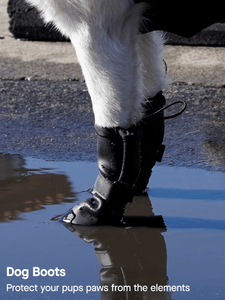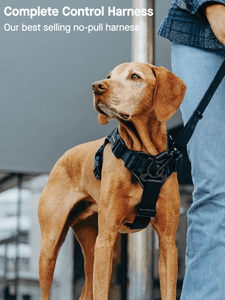Return to Blog
Training Big Pups: Positive Reinforcement Techniques for Harness Introduction
By Canada Pooch on Sep 25, 2023
Introducing a harness to your big pup can sometimes be a challenging task. It requires patience, understanding, and the right techniques. But if you know how to train your pooch and are consistent with practicing, you can have great success getting them adjusted to wearing a harness.
Understanding the Importance of Positive Reinforcement
Positive reinforcement is a fundamental aspect of effective dog training. This technique, highly recommended by various dog trainers and animal behavior experts, involves rewarding good behavior and discouraging pulling or unwanted behavior in dogs.
It's important to understand that dogs inherently seek to please their owners. By using positive reinforcement techniques, you can channel this instinct effectively towards achieving your training goals.
The Principles of Positive Reinforcement in Canine Training
The core principle of positive reinforcement dog training involves providing a reward, most commonly dog training treats, for the dog's desirable behavior. The timing of the reward is crucial - it should immediately follow the desired action to establish a clear link in the dog's mind.
The rewards can vary, from training treats to praise, petting, or toys. Regardless of the reward type, the key is consistency. Make dog training a rewarding and positive experience to maximize success.
Benefits of Positive Reinforcement for Big Pups
Training big pups using positive reinforcement offers numerous benefits. Not only does it facilitate mental stimulation and lay the groundwork for good behavior, but it also strengthens the bond between you and your pet.
Moreover, it encourages your big pup to pay attention back to you, making further training sessions more productive. Above all, positive reinforcement training can make leash walking enjoyable for both you and your pet.
Preparing for the Harness Introduction
When introducing a harness to your big pup, it's crucial to take accurate measurements to ensure it fits properly. A poorly fitted training harness can cause discomfort or even injury and may discourage your pet from accepting it.
Setting a Comfortable Environment for Harness Introduction
One of the positive reinforcement techniques for a smooth harness introduction involves introducing the training gear in a calm and comfortable environment. Minimize distractions and take things slow.
At first, you can allow the pup to sniff and explore the harness, then reward them with their favorite treats. Once your pup is comfortable with the harness, you can begin with short periods of wearing the harness indoors under your supervision. Gradually extend the duration of the training sessions and introduce outdoor walks once they're completely comfortable with the harness.
Remember, patience is key. Expect the unexpected and be ready to adapt your training methods accordingly. Follow these guidelines, and you'll be well on your way to mastering the art of positive reinforcement dog training.
Step-by-Step Guide to Harness Introduction
With these training tips and methods in mind, let's lay out a step-by-step guide to harness introduction.
Initial Introduction: Letting your Big Pup Explore the Harness
Remember to keep the introduction short and sweet. Let your pup sniff and interact with the harness for short periods. This allows your pet to acclimate to the new gear. You want your dog to associate the harness with good things, enhancing the effectiveness of positive reinforcement.
Harness Training Using Positive Reinforcement Techniques
Reward your pup whenever they show interest in the harness. You might consider using dog training treats as a positive reinforcement. However, keep in mind effective training isn't just about physical stimulation but also about mental stimulation.
An alternative to training treats could be playtime or praise. This encourages them to associate the harness with positive experiences. This is the crux of positive reinforcement dog training.
Progressing with Training: Safe and Comfortable Harness Wear
When your dog seems comfortable with the harness, begin putting it on them. Make sure you measure your dog accurately to get the perfect fit. The perfect fit is one that discourages pulling while not being too tight or chafing the skin. Make sure on consider your dogs weight and compare it to the manufacturers size guide to ensure a proper fit.
You want to gradually increase the duration that your dog wears the harness over a series of training sessions. This allows the dog to get used to the idea of wearing the harness without causing undue stress or anxiety.
Overcoming Common Challenges in Harness Training
Managing Harness-Wearing Anxiety with Positive Reinforcement
Some dogs may develop anxiety when wearing the harness. This could be due to a past negative experience or general discomfort. Take small steps and utilize positive reinforcement techniques to overcome this. A handy tip is to divert attention back to something the pet enjoys, like a favorite toy or treat.
Other techniques include agility training, recall training, and leash walking. These exercises not only provide physical and mental stimulation but help bring the dog's attention back to the task at hand.
In addition, always ensure that the harness features like its back clip or front clip suit your training goals and dog's nature. A back clip harness, for instance, offers more freedom for the dog but less control for you, which may not be ideal for training. Therefore, choose your training gear wisely.
Expert Techniques for Successful Harness Training
Harness Training Tips from Professional Dog Trainers
The first piece of advice any dog trainer will offer is to ensure the harness fits properly. According to experts, a perfect fit matters not just in providing physical stimulation but also in discouraging pulling. Animal behavior specialists advise that the attachment points of the harness should be carefully considered in the training session. For instance, a back clip on the harness encourages leash walking while a front clip discourages pulling.
Maintaining Harness Comfort for Big Pups
Comfort is a primary factor to consider in harness training. The harness material plays a significant role in securing the comfort of your big pup. Materials that cause skin irritation should be avoided. Additionally, the harness should not restrict movement.
Regular Checks and Adjustments for Optimal Harness Fit
The gear needs to be regularly checked and adjusted for accurate measurements. Irregular harness adjustments can lead to discomfort and may discourage the dog from wearing the training harness.
Ensuring Positive Experiences: The Role of Consistency in Harness Use
Consistency plays a crucial role in positive reinforcement training. Maintaining regular training session periods and using consistent tactics play a vital role in bringing the dogs' attention back and facilitating learning.
Persistent positive experiences in harness use create a positive relationship between the dog and the harness. This relationship aids in the dog accepting the harness without resistance.
Celebrating Success: Rewards and Acknowledgement in Harness Training
Acknowledging the successful completion of training objectives with a celebratory gesture helps in boosting dog morale. This celebration can involve treats or an enthusiastic rub which can act as a strong reinforcing factor in successful training outcomes. Keep a positive attitude and remain patient as your pup learns the way of the harness.
Always remember that every dog is unique and requires different training techniques and approaches. So, maintain patience and keep working until your pup is comfortable and relaxed wearing their harness.


